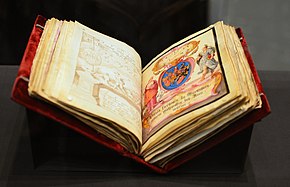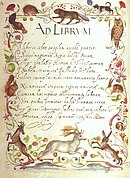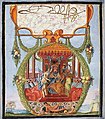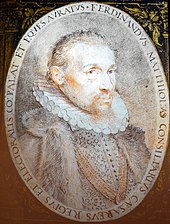Large stud book
The Great pedigree , as album Amicorum called, is one of the Augsburg merchant and art agents Philipp Hainhofer invested in the early 17th century pedigree . It is a collection of autographs illustrated with illustrations , which contains entries by numerous politically important personalities between 1596 and 1633. The studbook is considered an outstanding work of art because of its furnishings . Since the purchase for 2.8 million euros by the Herzog August Library in Wolfenbüttel in 2020 it will be in the local collection where it will be scientifically examined.
description

Double page (pages 179 and 180) with flowers and conchylia , around 1590–1595
|
The large archive book measures 21 × 18 cm and comprises 227 paginated pages made of paper , parchment and silk . Today it has a lace binding and a binding made of purple velvet . Originally, Philipp Hainhofer had used a screw fastening that allowed the pages to be exchanged.
Between 1596 and 1633, European rulers, such as the emperors Matthias and Rudolf II , as well as members of the nobility and the upper class, entered the book by hand. These include princes , diplomats, clergymen and generals , some of whom were protagonists of the Thirty Years War .
The entries consist of a page with personal sentences or poems in different languages, including German, French, Latin, Italian. In addition, there is usually a decorative leaf. The album contains richly decorated coats of arms and drawings in the Baroque style . Because of the high quality pictorial design, the book is also considered a collection album for art.
Hainhofer often had the pictorial representations of the entries made by renowned artists, which he commissioned at the expense of the entries. Based on Hainhofer's descriptions and the artists' signatures on their works, it was possible to reliably identify Joseph Heintz , Johann Matthias Kager , Lucas Kilian , Jacopo Ligozzi and Anton Mozart , among others . The artists are not yet known for many of the pictures, including the pages with floral motifs. They show tulips , which were new and precious in Europe at the time, and are reminiscent of the work of Georg Hoefnagel .
- Individual page entries
Page 16: Portrait of Emperor Rudolf II by Daniel Fröschl
Page 21: Entry of King Christian IV of Denmark and Norway with his own signature, 1620
Page 24: Entry by Elisabeth Stuart with her own signature and British coat of arms , 1616
Page 58: Entry by August II of Braunschweig-Lüneburg , 1613
Page 59: Entry by Ursula Duchess of Württemberg , 1614
Page list
The respective pages, their dates, the person making the entry and the type of entry are displayed in the drop-down list.
| page | Dating | Entering person | presentation |
|---|---|---|---|
| 1 | 1600 | Title page with three quotes in French, Italian and Latin as well as Philipp Hainhofer's name and coat of arms in a border. | |
| 4-5 | Latin dedications to the book (Ad Librum) and the reader (Ad Lectorem) with a pictorial border of animals jumping over tendrils of fruit and flowers. | ||
| 8th | Johann Schweikhard von Kronberg , Archbishop of Mainz | Signature, full coat of arms and motto as well as ink drawing of travelers in a landscape, signed with the monogram of Anton Mozart . | |
| 10 | 1624 | Władysław IV. Wasa , King of Poland | Signature, coat of arms and motto on an emblematic painting. |
| 13th | 1633 | Gustaf Horn , Commander of the Swedish Army in Germany | Signature, coat of arms and motto. |
| 16-17 | Rudolf II , Holy Roman Emperor | Portrait by Daniel Fröschl and signature with pictorial representation with landscape background and scene with the emperor, flanked by two allegorical figures. | |
| 20th | Matthias , Holy Roman Emperor | Signature, full coat of arms and representation of four virtues. | |
| 21st | 1620 | Christian IV , King of Denmark and Norway | Signature, full coat of arms and motto. |
| 24 | 1616 | Elisabeth Stuart , Electress of the Palatinate | Signature, motto and full British coat of arms worn by putti , painted by Johann Matthias Kager . |
| 25th | Friedrich V , Elector Palatinate | Signature and allegorical pen drawing. | |
| 30-31 | Cosimo II. De 'Medici , Grand Duke of Tuscany | Signature, motto and a painted page with his crowned coat of arms, flanked by seated figures of justice and steadfastness, painted by Jacopo Ligozzi . | |
| 33 | 1608 | Joachim Ernst , Margrave of Ansbach | Signature and full coat of arms depicting angels playing music, painted by Anton Mozart. |
| 36 | 1612 | Philip II , Duke of Pomerania-Stettin | Signature, motto and coat of arms, surrounded by emblematic medallions and depiction of an allegorical landscape, painted by Johann Matthias Kager. |
| 37 | Philip II, Duke of Pomerania-Stettin | Calligraphic portrait in black ink with gold frame. | |
| 39 | 1613 | Johann Friedrich , Duke of Württemberg | Signature and coat of arms, above birds and animals. |
| 41 | 1612 | Leopold V , Archduke of Austria-Tyrol | Signature, motto and coat of arms with two angels. |
| 43 | 1616 | Barbara Sophia of Brandenburg , Duchess of Württemberg | Signature and coat of arms as well as two putti holding a scroll. |
| 45 | 1616 | * Barbara Sophia von Brandenburg, Duchess of Württemberg * Agnes von Württemberg (1592–1629), wife of Franz Julius von Sachsen-Lauenburg * Anna von Württemberg (1597–1650), daughter of Duke Friedrich I. |
Signatures, motto and coats of arms. |
| 50 | 1620 | Adolf von Schleswig-Holstein-Gottorf , princely military | Signature, motto and depiction of a goddess of war holding a shield with her coat of arms. |
| 51 | 1630 | Johann Wilhelm , Duke of Saxe-Altenburg | Signature, motto and coat of arms with a putto. |
| 53 | 1618 | Drawing of the heads of Ceres , Venus and Bacchus based on the motif Sine Cerere et Baccho friget Venus . | |
| 55 | 1614 | Ludwig V , Landgrave of Hesse-Darmstadt | Signature and coat of arms. |
| 58 | 1613 | August the Younger , Duke of Braunschweig-Lüneburg | Signature, motto and dedication to "suo amico" Philipp Hainhofer in a pen drawing with the Annunciation to the Shepherds , drawn by Lucas Kilian . |
| 59 | 1614 | Ursula von Pfalz-Veldenz-Lützelstein , Duchess of Württemberg, 1614 | Name and coat of arms with allegorical female figures. |
| 62 | 1616 | Georg Friedrich , Margrave of Baden and Protestant military leader | Signature, full coat of arms and figures of faith and justice, painted by Tobias Bernhart. |
| 65 | 1619 | Clara Maria von Pommern (1574–1623), first wife of Duke August the Younger | Signature and coat of arms, flanked by Saint Catherine of Siena and the Virgin of the Immaculate Conception . |
| 68 | 1613 | Karl Friedrich I , Duke of Munsterberg | Signature and coat of arms, surrounded by angels with instruments of the Passion, drawn by Lucas Kilian. |
| 69 | 1613 | Ludwig Friedrich , Duke of Württemberg-Mömpelgard | Signature, motto and coat of arms in a frame of insects, flowers and shells. |
| 71 | 1624 | Alessandro Orsini , Cardinal of the Roman Church | Signature over a painting of a bear. |
| 73 | 1621 | Charles de Valois , Duke of Auvergne and Angoulême | Signature above his painted coat of arms. |
| 75 | 1625 | Aloysio Gonzaga , Prince of Castiglione Ferdinando Gonzaga |
Signatures under painted coats of arms. |
| 78 | 1613 | Wolfgang Wilhelm von Pfalz-Neuburg , Imperial Prince from the House of Wittelsbach | Signature and coat of arms with painted surroundings, including putti while making music. |
| 80 | 1612 | Heinrich Wenzel , Duke of Munsterberg | Signature, full coat of arms and motto. |
| 84 | 1612 | Maria Dorothea von Württemberg (1559–1639), wife of Duke Otto Heinrich | Signature, coat of arms and motto with a scene with a landscape background and figures of justice and charity, signed by Anton Mozart. |
| 85 | 1612 | * Sabine (1589–1661), daughter of Duke Otto Heinrich * Susanna (1591–1667), wife of Count Palatine Georg Johann II. |
Signatures and motto. |
| 90-91 | 1614 | August , Duke of Sulzbach | Signature, motto and coat of arms, surrounded by two full-page embroideries made of silk and gold thread depicting a canopy in a landscape and a massacre of innocents. |
| 94 | * Johann Georg I , Elector of Saxony * Moritz , Duke of Saxony-Zeitz |
Signatures and motto. | |
| 95 | Full-page painting of a landscape with Prince Elector Johann Georg I and his sons Augustus , Christian and Moritz astride a horse with a pink mane . | ||
| 100 | 1619 | Friedrich Achilles , Duke of Württemberg | Signature, motto and coat of arms in an artistic architectural setting with putti. |
| 101 | 1623 | Joachim Ernst , Duke of Schleswig-Holstein-Plön | Signature and motto. |
| 103 | François de Lorraine (1571–1632), Count of Vaudemont | Signature, full coat of arms and motto. | |
| 106 | 1630 | Georg II , Landgrave of Hesse-Darmstadt. | Signature, coat of arms and motto with symbolic memories of mortality. |
| 108 | 1615 | Anna von Pommern , member of the griffin family | Signature and full coat of arms. |
| 109 | 1617 | Anna Maria , Duchess of Pomerania | Signature, motto and full coat of arms framed by two winged mermaids. |
| 112 | 1632 | Hans, Duke of Schleswig-Holstein-Gottorf (1606–1655) | Signature, motto and coat of arms held by a figure of charity. |
| 113 | 1632 | Alexander Heinrich (1608–1667), Duke of Schleswig-Holstein-Sonderburg | Signature and motto as well as a naked figure of good fortune that catches the wind in her sail. |
| 116 | 1614 | Friedrich I , Landgrave of Hesse-Homburg | Signature, full coat of arms and motto. |
| 118 | 1630 | Marguerite von Béthune († 1661), wife of Duke Henri II. De Rohan | Signature, full coat of arms and dedication. |
| 119 | 1630 | Marguerite de Rohan (1617–1684), daughter of Duke Henri II. De Rohan | Signature, full coat of arms and dedication. |
| 124-125 | 1610 | Francesco Contarini , Doge of Venice | Allegorical painting with coat of arms and inscription by a Venetian painter. |
| 125 | 1614 | Johann Christoph von Westerstetten , Prince-Bishop of Eichstätt | Signature and representation of putti, slogans and the figures of justice and peace. |
| 128-129 | 1616 | Moritz of Orange , governor of the united Netherlands | Signature and coat of arms. |
| 131 | 1608 | Giovanni de ' Medici , Prime Minister of his nephew Cosimo II. | Signature, motto and coat of arms depicting animals, fish, reptiles, birds and flowers that represent the four elements and seasons. |
| 134 | 1616 | Johann Albrecht I (1563–1623), Count of Solms-Braunfels | Signature and coat of arms. |
| 135 | 1616 | Adam Gottfried Berca, Baron von Berka von Dubá | Signature, motto and coat of arms on the shield of an armored knight on horseback. |
| 137 | 1596 | Ludwig Eberhard zu Oettingen-Oettingen (1577–1634), Count | Signature, dedication and coat of arms in a border of seated birds. |
| 138-139 | Double page with flowers, shells and insects within a border of shells. | ||
| 140 | 1597 | Ludwig (1579–1643), Count of Erbach | Signature, motto and coat of arms in a border made up of birds and a bat. |
| 143 | Vratislaus I., Prince of Fürstenberg | Signature, motto and coat of arms. | |
| 146 | 1627 | George IV , Count of Ortenburg | Signature, full coat of arms and painted scene with industrial mining. |
| 147 | 1629 | Philipp Ernst von Mansfeld- Artern (1560–1631), Elector of Saxony captain | Signature, motto and coat of arms with two palaces. |
| 148 | 1630 | * Franz Christoph von Teuffenbach * Sybilla von Teuffenbach, b. von Herberstein * Christoph von Welz, Baron von Eberstein |
Signatures, slogans and coats of arms in front of a spacious landscape with a harvest scene. |
| 149 | 1608 | Georg Friedrich, Count of Hardegg and von Glatz | Signature, motto and coat of arms with canopy. |
| 152 | 1626 | Friedrich Casimir , Count of Ortenburg | Signature, full coat of arms and motto. |
| 153 | 1625 | Baron Georg von Wartenberg († 1632) | Signature, motto and coat of arms with a winged ermine. |
| 156 | 1616 | Johann Conrad von Rosenbach , Johanniter in the Commandery Rothenburg ob der Tauber | Signature, motto and coat of arms. |
| 157 | Full-page painting of a sea battle with the conquest of the Turkish galley Sultana by galleys of the Order of Malta . | ||
| 160 | 1609 | Jehan Phelipaux, advisor to Henry IV of France | Signature, motto, dedication and coat of arms. |
| 162 | Johann Friedrich, Count von Schwarzenberg and Baron von Hohenlandsberg | Signature, motto and coat of arms in a painted border with leaves and birds. | |
| 163 | Painting with a landscape that Philipp Hainhofer described in 1610 as “a very beautiful landscape of the Netherlands ...... as Leander wants to swim over the water to Heron with the poppy shine”. | ||
| 164 | Painting with a boy with a basket of pretzels and a clock surrounded by leaves and animals. | ||
| 165 | 1596 | Christoph, Count von Schwarzenberg and Baron von Hohenlandsberg | Motto and coat of arms in a painted border with flowers and reptiles. |
| 168 | 1621 | Per Brahe , Count of Visingsborg | Signature, motto and coat of arms. |
| 169 | 1618 | Johann Conrad, Wild and Rhine Count of Dhaun | Signature, motto and coat of arms. |
| 174 | Marx Fugger (1564–1614), Count of Kirchberg and Weißenhorn | Signature, full coat of arms and depiction of a lion and an evangelist, painted by Johann Matthias Kager. | |
| 175 | 1616 | Johann Casimir, Count of Beckenstein | Signature, full coat of arms and motto with a representation of fish. |
| 178 | Philippe de Canaye, Sieur du Fresne (1551–1610), French diplomat and envoy to Henry IV in the Republic of Venice | Signature and full coat of arms. | |
| 179 | 1596 | Georg Christoph Urschenbeck | Signature, motto and coat of arms in a painted border with birds and insects. |
| 179-180 | Double page with flowers in a border of shells. | ||
| 182 | 1608 | Bonaventura de Lafont, Count | Signature, motto and coat of arms in a painted border with birds. |
| 183 | 1611 | Jacques Bongars , French diplomat | Signature, motto and coat of arms depicting pansies and hearts. |
| 186 | Drawing of a naked woman with musical instruments and a peacock. | ||
| 187 | 1596 | Johann Christoph, Baron von Puchheim , Lord of Göllersdorf | Signature, motto and coat of arms in a painted border with butterflies. |
| 190 | 1629 | * Hans Paul, Baron von Wolzüge * Hans Sigismund, Baron von Wolzüge |
Motto and coat of arms. |
| 192 | 1611 | Zacharias Geizkofler , Reichspfennigmeister of the Holy Roman Empire | Signature, full coat of arms and motto. |
| 194 | 1606 | Hans Wilheim von Riedheim and Angelberg , nobleman from Swabia | Signature, motto and dedication. |
| 195 | Johann Adam, Baron von Vöhlin | Signature and motto on a scroll held by two crowned angels. The coat of arms is depicted with Minerva with symbols of war and peace. | |
| 198 | 1626 | Peter Ernst, Baron von Ernhingen and Pittingen | Signature and coat of arms pendant with the head of an angel. |
| 200 | 1614 | Hugoldt Beer on Hugoldsdorf | Signature and motto. |
| 201 | 1607 | Servatius Reichelt (1573–1624), Assesor at the Regional Court of the Principality of Breslau | Signature, prayer and dedication. |
| 203 | 1629 | Matthias Hoë von Hoënegg , electoral court preacher | Signature, coat of arms and motto. |
| 205 | Drawing with pen and chalk The three Marys at the grave of Georg Behem. | ||
| 208 | Lamoral of taxis , imperial chamberlain | Signature, motto and coat of arms. | |
| 209 | Pen-and-ink drawing as a copy of an engraving showing the killing of the Duke of Guise in 1563. | ||
| 211 | Signature and pen drawing of a blank sign on a hill. | ||
| 214-215 | 1602 | Ferdinand Matthioli (1565–1625), doctor and advisor to Emperor Matthias | Coat of arms of Ferdinand II , King of Bohemia, in gold on black with the date 1618 on page 214. Portrait drawing of Ferdinand Matthioli in red and black chalk by Joseph Heintz the Elder on page 215. |
Emergence
Since their appearance in the 1530s, family records in the vicinity of the University of Wittenberg and the reformers there have been signs of personal networking . Against this background, the Augsburg merchant's son Philipp Hainhofer began collecting entries in the archives in 1596 on an educational trip through Italy. Most of the entries were probably made later during his business trips or when visiting guests from abroad in his art collection in Augsburg. Sheets that were apparently requested were also inserted, which were sent by post. From around 1610 Hainhofer practiced a political functionalization of his stud book. He received invitations to audiences from the prominent entries . Even when it was being created, the Große Stammbuch was a tourist attraction that Philipp Hainhofer visitors in Augsburg were happy to show them to. According to a contemporary source, as early as the 17th century, the "extremely artificial stud book, the same should not be seen" was a sensation.
In addition, with the Wolfenbütteler Stammbuch with 532 pages and the Augsburger Stammbuch with 116 pages, two further records by Philipp Hainhofer are known.
Acquisitions and whereabouts
From 1613 onwards, Philipp Hainhofer worked for decades as an agent, factor and correspondent for Duke August II of Braunschweig-Lüneburg , who paid him an annual salary of 600 Reichstalers . After Philipp Hainhofer's death, his son Georg Ulrich Hainhofer (1614–1659) was the main heir. After his death in 1659, Duke August II of Braunschweig-Lüneburg sought the written estate of Philipp Hainhofer. Almost all of it came to Wolfenbüttel with travelogues, correspondence and lute books . There the writings were entered in the catalog of the Herzog August Library between 1660 and 1663. Two of the three Philipp Hainhofer family records belonged to the estate, but not the large family record book .
The work was considered lost for centuries. In 1931 and again in 1941 it appeared in the sales catalog of the London antiquarian bookstore Bernard Quaritch Ltd. for 600 pounds on. In 1946, the American Cornelius Hauck (1893-1967) from Cincinnati acquired the book because of his botanical interest in the plant images it contains. In 2006, it was auctioned from his property at Christie's in New York . The estimate was $ 600,000 to $ 800,000 . The Herzog August Bibliothek failed to bid because the work went to a British private collection for almost $ 2.4 million via the London second-hand bookshop Maggs Brothers. In 2019, the Large Stammbuch was offered for sale exclusively to the Herzog August Library by a private collector through the auction house Sotheby’s . The sales negotiations, overshadowed by Brexit and the Corona crisis , dragged on for over a year. In 2020, the library acquired the work for 2.8 million euros. The funds were provided by the State of Lower Saxony, the Federal Government Commissioner for Culture and the Media , the State Cultural Foundation and other foundations , including the Volkswagen Foundation , the Ernst von Siemens Art Foundation , the Lower Saxony Foundation and the Rudolf-August Oetker Foundation . According to the director of the Herzog August Library, Peter Burschel , it is the most significant purchase since the acquisition of the medieval Gospel of Henry the Lion in 1983.
Exploration and exhibition

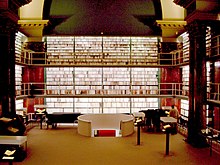
The purchase of the Large Studbook from the Herzog August Library was announced to the public at a press conference on August 25, 2020 in the Sprengel Museum Hanover . It is now accessible to research for the first time. According to the experts, the Herzog August Library as a suitable research library world's best for the research and presentation of the work. For historians, like the rest of Hainhofer's written estate, it represents an important source of the cultural and political networks of the German courts in the 17th century. Associated with the purchase is a three-year research project by the Herzog August Library, in which the creation and The history of the work and its artistic design are scientifically examined. The research project is financed with 300,000 euros from the state of Lower Saxony from funds from the Volkswagen Foundation. During the project, the work is to be digitized and made available online. An exhibition is planned for the public, in which the large family record will be shown within the scope of what is reasonable in terms of conservation.
The Große Stammbuch in the collection of the Herzog August Bibliothek bears the signature Cod. Guelf. 355 Noviss. 8 ° . and is kept in an air-conditioned, accessible safe in the library, in which the Gospels of Henry the Lion are also stored.
meaning
The Great pedigree is true of the three ordinary books of Philip Hainhofer as the artistic and cultural history important. According to experts, it surpasses the 25,000 documented family records worldwide in terms of equipment and political significance. The people who registered in the Grand Register were privileged and belonged to the upper class. According to Peter Burschel from the Herzog August Library, Philipp Hainhofer got the elites of the time to sign his book. For him it was a business model that served as a door opener in aristocratic circles in order to establish a long-term trading relationship and to receive follow-up orders for other art objects. With the book, which was already a sensation at the time, Philipp Hainhofer gained access to the most important political decision-makers of his time.
Individual media refer to the book as the Who's Who of the 17th century. The Lower Saxony Science Minister Björn Thümler considers it to be an "outstanding cultural treasure of national rank".
literature
- Michael Wenzel: Philipp Hainhofer: dealing with art and politics , Berlin, 2020
- Business model family register , pp. 65–64
- Family books as actants , pp. 119–140
Web links
- Philipp Hainhofer's Large Studbook or How do you collect “friends”? at Herzog August Library
- Album amicorum. Large studbook at Augsburg University of Applied Sciences (English)
- "Album Amicorum" - A lost treasure returns , press release from the Lower Saxony Ministry for Science and Culture from August 25, 2020
- Herzog August Bibliothek acquires Philipp Hainhofer's Large Studbook from the Kulturstiftung der Länder on August 25, 2020
- Library buys old book for around 2.8 million euros in Hannoversche Allgemeine Zeitung from August 19, 2020
Individual evidence
- ^ The History of the Book: The Cornelius J. Hauck Collection at Christie's, Lot 263, 27. – 28. June 2006
- ↑ Philipp Hainhofer's family books at Herzog August Bibliothek, Wolfenbüttel
- ↑ Wolfenbütteler Stammbuch Philipp Hainhofers, 1593–1631 at Herzog August Bibliothek Wolfenbüttel
- ↑ Philipp Hainhofer's Augsburg family book, 1596–1619 at Herzog August Bibliothek Wolfenbüttel
- ^ Willi Winkler: Queen of Stud Books in Süddeutsche Zeitung from August 25, 2020
- ^ Ten Most Expensive Books of 2006 at Fine Books & Collections
- ↑ Lisa Zeitz: A whole album for friendship: High prices in New York for the collection of Cornelius Hauck in FAZ from July 3, 2006
- ↑ The 2.8 million euro book is being researched for a further 300,000 euros in: Hannoversche Allgemeine Zeitung from 25 August 2020
- ↑ Spectacular new acquisition: HAB buys "Album Amicorum" from regionalHeute.de on August 25, 2020
- ↑ Large family record of Philipp Hainhofers, 1596–1633, manuscript, Herzog August Bibliothek Wolfenbüttel, signature Cod. Guelf. 355 Noviss. 8 ° at the Herzog August Library
- ↑ Library acquires album with Europe's rulers in Westfälische Nachrichten from August 25, 2020
- ↑ 400 year old book presented in Hanover at ndr.de on August 25, 2020
